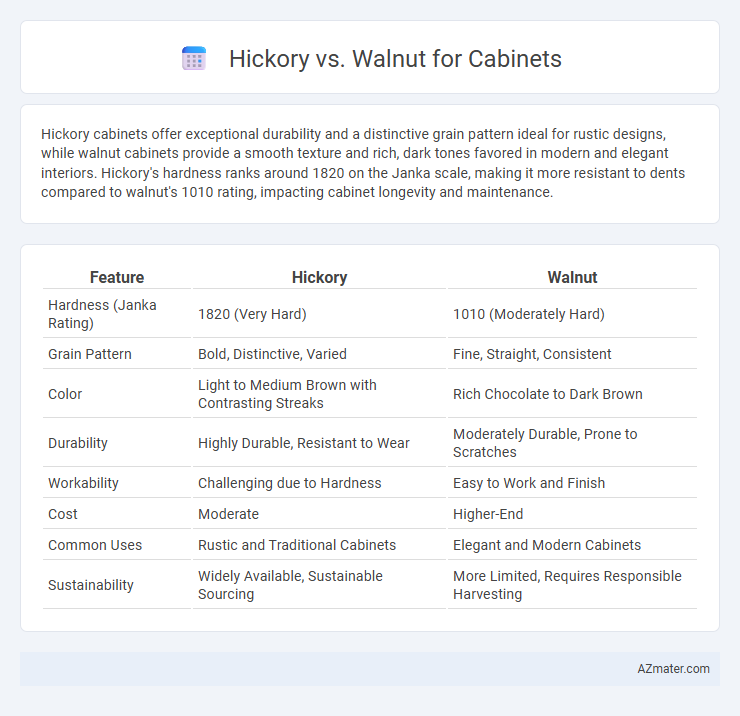Hickory cabinets offer exceptional durability and a distinctive grain pattern ideal for rustic designs, while walnut cabinets provide a smooth texture and rich, dark tones favored in modern and elegant interiors. Hickory's hardness ranks around 1820 on the Janka scale, making it more resistant to dents compared to walnut's 1010 rating, impacting cabinet longevity and maintenance.
Table of Comparison
| Feature | Hickory | Walnut |
|---|---|---|
| Hardness (Janka Rating) | 1820 (Very Hard) | 1010 (Moderately Hard) |
| Grain Pattern | Bold, Distinctive, Varied | Fine, Straight, Consistent |
| Color | Light to Medium Brown with Contrasting Streaks | Rich Chocolate to Dark Brown |
| Durability | Highly Durable, Resistant to Wear | Moderately Durable, Prone to Scratches |
| Workability | Challenging due to Hardness | Easy to Work and Finish |
| Cost | Moderate | Higher-End |
| Common Uses | Rustic and Traditional Cabinets | Elegant and Modern Cabinets |
| Sustainability | Widely Available, Sustainable Sourcing | More Limited, Requires Responsible Harvesting |
Introduction to Hickory and Walnut Cabinets
Hickory cabinets are prized for their exceptional hardness, unique grain patterns, and rich color variations ranging from creamy white to deep reddish-brown, making them durable and visually striking choices for kitchens. Walnut cabinets feature a smooth texture with consistent dark brown hues complemented by subtle purples and greys, offering a sleek, modern look with natural warmth. Both woods stand out in cabinetry for combining strength, aesthetic appeal, and longevity, making them ideal selections for high-quality kitchen designs.
Key Visual Differences: Hickory vs Walnut
Hickory cabinets showcase a distinctive grain pattern with pronounced knots and contrasting light and dark streaks, offering a rustic and textured appearance. Walnut cabinets feature a smooth, straight grain and rich chocolate to deep brown hues, providing a sleek and elegant look. The key visual difference lies in hickory's dynamic color variation versus walnut's uniform, sophisticated tone.
Durability and Hardness Comparison
Hickory and walnut are both popular choices for cabinets, with hickory exhibiting a Janka hardness rating around 1,820, making it one of the hardest domestic hardwoods, while walnut ranks significantly lower at approximately 1,010. Hickory's durability excels in resisting dents and scratches, ideal for high-traffic kitchen environments, whereas walnut offers moderate hardness combined with rich color and smoother grain patterns, better suited for decorative cabinetry. Cabinets made from hickory endure heavy use and impact longer, but walnut provides a balance of durability and aesthetic appeal favored in less demanding applications.
Color and Grain Patterns
Hickory cabinets exhibit bold color contrasts with creamy whites and rich browns, featuring prominent, varied grain patterns that create a rustic, textured appearance. Walnut cabinets showcase deep, warm chocolate tones with subtle purples and tans, having smooth, straight grain patterns that give a sleek and elegant finish. The vibrant, dynamic look of hickory is ideal for country-style kitchens, while walnut's consistent grain and rich color suit modern and traditional upscale designs.
Cost and Budget Considerations
Hickory cabinets typically cost between $6 to $10 per board foot, making them a more affordable option compared to walnut, which ranges from $10 to $15 per board foot. Hickory's lower price point suits budget-conscious projects while still offering durability and a distinctive grain pattern. Walnut cabinets, although pricier, provide a rich, dark finish and high-end appeal that can enhance the overall value of a kitchen remodel.
Maintenance and Longevity
Hickory cabinets offer exceptional durability and resistance to dents, requiring minimal maintenance with occasional polishing to preserve their natural luster. Walnut cabinets, prized for their rich, dark grain, demand more careful upkeep, including regular conditioning to prevent drying and fading over time. Both woods provide long-lasting cabinetry solutions, but hickory's hardness and resilience make it more suitable for high-traffic areas needing low-maintenance care.
Suitability for Different Interior Styles
Hickory cabinets offer a rustic, warm aesthetic with prominent grain patterns ideal for farmhouse and traditional interiors. Walnut cabinets provide a rich, dark finish with smooth textures that complement modern, mid-century, and contemporary styles. Choosing between hickory and walnut depends on the desired ambiance, with hickory emphasizing natural, rugged charm and walnut delivering elegance and sophistication.
Environmental Impact and Sustainability
Hickory cabinets offer faster growth rates and higher density, contributing to sustainable forestry by reducing habitat disruption and promoting efficient resource use. Walnut, known for slower growth and higher demand, typically requires more extended harvesting cycles, impacting forest regeneration rates and carbon sequestration negatively. Choosing Hickory supports eco-friendly practices through quicker replenishment, while Walnut's premium status demands careful sourcing from certified sustainable forests to minimize environmental impact.
Pros and Cons of Hickory Cabinets
Hickory cabinets offer exceptional durability and striking natural grain patterns, making them ideal for rustic and traditional kitchen designs. Their hardness provides resistance to dents and scratches, although the wood's density can make installation and modifications more challenging. Hickory's lighter color may require staining or finishing to match darker cabinetry preferences, but it ages beautifully with a warm patina over time.
Pros and Cons of Walnut Cabinets
Walnut cabinets offer rich, deep color and striking grain patterns that enhance kitchen aesthetics, providing a luxurious and timeless appeal. Their durability and resistance to shrinking or warping make walnut an excellent choice for long-lasting cabinetry, though their higher cost and susceptibility to dents compared to harder woods can be drawbacks. Walnut wood's natural warmth complements both modern and traditional designs, but requires regular maintenance to preserve its finish and prevent fading from prolonged sun exposure.

Infographic: Hickory vs Walnut for Cabinet
 azmater.com
azmater.com